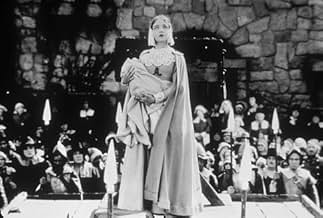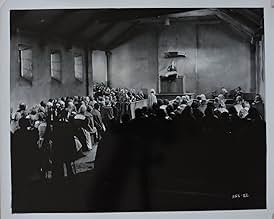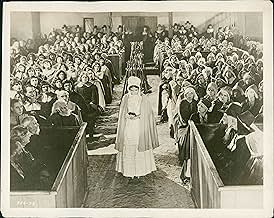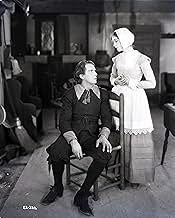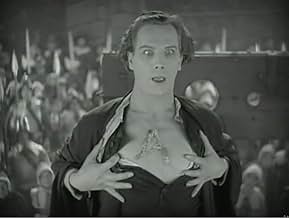IMDb RATING
7.6/10
2.1K
YOUR RATING
After having a baby out of wedlock, a young Puritan woman is pressured to reveal the name of her lover.After having a baby out of wedlock, a young Puritan woman is pressured to reveal the name of her lover.After having a baby out of wedlock, a young Puritan woman is pressured to reveal the name of her lover.
- Awards
- 1 win total
Buck Black
- Child in crowd
- (uncredited)
Nora Cecil
- Townswoman
- (uncredited)
Iron Eyes Cody
- Young Indian at Dunking
- (uncredited)
Artye Folz
- Child
- (uncredited)
Dorothy Gray
- Child
- (uncredited)
Douglas Haig
- Minor Role
- (uncredited)
Betsy Ann Hisle
- Child
- (uncredited)
Featured reviews
10Doug-193
Exactly what we've lost since the end of the silent era is magnificently on display in Victor Seastrom's THE SCARLET LETTER: shimmering black and white photography of superbly composed and paced scenes capturing the essence of the American classic novel by Hawthorne, though certain details of the story have been altered and may annoy literary purists. This is not the novel but a separate work, more than a perceptive and intelligent picturization. Here is the great, lost art of silent screen acting, with Lillian Gish, unforgettable as Hesther Prynne, leading an accomplished cast. The result is pure visual poetry.
It was a novel Hollywood didn't want to touch in the mid-1920s, even though the 1850 classic was brought to the screen six times earlier. The recently-established Will Hays office had its censorship fangs out. A story about a married woman who gets pregnant by a lover was cause for alarm for most movie studios.
Lilian Gish, one of silent film's major star, had long wanted to bring Nathaniel Hawthorne's 'The Scarlet Letter' in an updated version to the screen. Contracted to MGM in a three-picture deal, she convinced the studio's head of production, Irving Thalberg, she could deliver a tasteful version of Hawthorne's book without moralistic tongue-waggers complaining. With a script by Frances Marion, which follows the novel closely, MGM's August 1926's "The Scarlet Letter" has been praised as the best version of the book in a long-line of past and future movie adaptations.
Its success can be attributed to Gish herself, who portrays Hester Prynne. She hasn't heard from her husband who traveled overseas for several years from their Puritan Boston, Massachusetts, home in the mid-1600s. She becomes pregnant from a man whom she doesn't disclose the name. The Gish version departs from Hawthorne in a couple of major ways: the film begins a year earlier than the author's, showing her condemned to a stockade for leaping and dancing after her song bird escapes its cage. It's there where she meets the Reverend Arthur Dimmesdale (Lars Hanson). Also, the films unveils the love relationship between the minister and Hester, not keeping secret of who's the father of the baby.
Another reason for the movie's overall financial popularity is Swedish director Victor Sjostrom's unique directing. He allowed Gish the freedom to display her attractiveness by literally letting her hair down in a clandestine meeting with Dimmesdale in the woods, reflecting Hester's modernistic independence. Gish had the choice in selecting the director, and she picked Sjostrom because she "felt the Swedes were closer to the feelings of New England Puritans than modern Americans." She also favored Hanson as Dimmesdale from his 1924 performance in "The Saga of Gosta Berling." Hanson, who knew very little English, elected to speak his lines (it was a silent movie after all) in Swedish while Gish spoke English in scenes where they're together. Homesick actress Greta Garbo, recently arriving in America from Sweden after signing a contract with MGM, was a near daily presence on the set since she was comfortable speaking her native language with Hanson.
With two weeks of filming to go, Lillian found out her mother suffered a stroke in London and reportedly dying. Dorothy, her sister, urged her to catch the first boat to England to attend to her. In a near impossible request, Lillian asked Sjostrom she needed to leave in three days to travel by train to New York City, then on to a liner to London. The director didn't flitch. He designed an almost around-the-clock schedule to film all of Gish's parts-as long as the crew agreed to the grueling sleepless itinerary. The workers heartedly agreed.
"The Scarlet Letter" is still admired for Sjostrom's creation of an environmental rise en scene that underscored the film's characters' emotion and psychology by its pastoral recreation of a 17th century village. Even though the residents of Salem, MA, where the story takes place, were insulted by their forefathers' portrayal in the film, the American Film Institute nominated it as one of the most passionate motion pictures ever made as well as nominated Hester Prynne as one of movie's most admired heroes.
Lilian Gish, one of silent film's major star, had long wanted to bring Nathaniel Hawthorne's 'The Scarlet Letter' in an updated version to the screen. Contracted to MGM in a three-picture deal, she convinced the studio's head of production, Irving Thalberg, she could deliver a tasteful version of Hawthorne's book without moralistic tongue-waggers complaining. With a script by Frances Marion, which follows the novel closely, MGM's August 1926's "The Scarlet Letter" has been praised as the best version of the book in a long-line of past and future movie adaptations.
Its success can be attributed to Gish herself, who portrays Hester Prynne. She hasn't heard from her husband who traveled overseas for several years from their Puritan Boston, Massachusetts, home in the mid-1600s. She becomes pregnant from a man whom she doesn't disclose the name. The Gish version departs from Hawthorne in a couple of major ways: the film begins a year earlier than the author's, showing her condemned to a stockade for leaping and dancing after her song bird escapes its cage. It's there where she meets the Reverend Arthur Dimmesdale (Lars Hanson). Also, the films unveils the love relationship between the minister and Hester, not keeping secret of who's the father of the baby.
Another reason for the movie's overall financial popularity is Swedish director Victor Sjostrom's unique directing. He allowed Gish the freedom to display her attractiveness by literally letting her hair down in a clandestine meeting with Dimmesdale in the woods, reflecting Hester's modernistic independence. Gish had the choice in selecting the director, and she picked Sjostrom because she "felt the Swedes were closer to the feelings of New England Puritans than modern Americans." She also favored Hanson as Dimmesdale from his 1924 performance in "The Saga of Gosta Berling." Hanson, who knew very little English, elected to speak his lines (it was a silent movie after all) in Swedish while Gish spoke English in scenes where they're together. Homesick actress Greta Garbo, recently arriving in America from Sweden after signing a contract with MGM, was a near daily presence on the set since she was comfortable speaking her native language with Hanson.
With two weeks of filming to go, Lillian found out her mother suffered a stroke in London and reportedly dying. Dorothy, her sister, urged her to catch the first boat to England to attend to her. In a near impossible request, Lillian asked Sjostrom she needed to leave in three days to travel by train to New York City, then on to a liner to London. The director didn't flitch. He designed an almost around-the-clock schedule to film all of Gish's parts-as long as the crew agreed to the grueling sleepless itinerary. The workers heartedly agreed.
"The Scarlet Letter" is still admired for Sjostrom's creation of an environmental rise en scene that underscored the film's characters' emotion and psychology by its pastoral recreation of a 17th century village. Even though the residents of Salem, MA, where the story takes place, were insulted by their forefathers' portrayal in the film, the American Film Institute nominated it as one of the most passionate motion pictures ever made as well as nominated Hester Prynne as one of movie's most admired heroes.
I love this film for everything that it is. The story, the acting, the direction, everything about it is great.
The story revolves around Hester Prynne(Lillian Gish) and her love for the Reverrend Arthur Dimmesdale(Lars Hanson). Poor Hester is marked with the 'scarlet letter' when she gives birth to her lovechild with the bishop, and the bishop suffers on his own as his heart begins to fail on account of the guilt he feels.
The orchestration of this film helps a lot because the wonderful music helps you follow the story more and bring intensity. I love Lars Hanson's performance, he has the perfect profile for love scenes.
The story revolves around Hester Prynne(Lillian Gish) and her love for the Reverrend Arthur Dimmesdale(Lars Hanson). Poor Hester is marked with the 'scarlet letter' when she gives birth to her lovechild with the bishop, and the bishop suffers on his own as his heart begins to fail on account of the guilt he feels.
The orchestration of this film helps a lot because the wonderful music helps you follow the story more and bring intensity. I love Lars Hanson's performance, he has the perfect profile for love scenes.
A young mother is forced to wear THE SCARLET LETTER of adultery by her repressive society.
Nathaniel Hawthorne's classic novel is brought brilliantly to life in this excellent Silent film from MGM. Because the book was on the censored list, Lillian Gish, the era's finest actress, had to campaign vigorously with both the studio hierarchy and civic morality groups around the country to be allowed to make the film, causing her to ironically deal with the same sort of moral strictures her heroine would face in the film.
Her persistence paid off. She was able to obtain the services of director Victor Sjöström and actor Lars Hanson, both from Sweden. Sjöström instructed Miss Gish in the Scandinavian method of natural acting and he gave the film a blunt, no-nonsense look, crisp & clean, utilizing the Studio's excellent sets to the best of their advantage. Frances Marion, the most celebrated screenwriter of the day, was responsible for the literate script.
As the much harried Hester Prynne, Gish is beatific, her face radiating as if from an inner glow. She is playfully sweet as the community seamstress, wanting to cavort on the Sabbath or wear frilly clothing, only two of the actions proscribed & punishable by the Puritans' implacable rigidity. Later, with Hanson, she takes the viewer along as she delights in her new, hidden joy as he returns her love. Whether calmly standing on the scaffold to endure her shame, or fiercely protecting the unbaptized offspring of her forbidden passion, Gish never for an instant loses her grip on the pathetic character she's portraying.
Although he spoke no English, this was not a hindrance to Hanson. Playing the conflicted Rev. Arthur Dimmesdale, Boston's saintly parson, he paints the portrait of a good man literally dying of guilt, a weak man who dare not defend his wife & child. Hanson's face reflects his agony, his left hand twitching at his own breast where his secret symbol of shame is hidden. With Gish unobtainable in this world, he moves steadily towards the inevitable, and deeply poignant, conclusion.
Henry B. Walthall, Miss Lillian's costar in Griffith's THE BIRTH OF A NATION (1915), has the supporting role of a mysterious stranger whose arrival in Boston foreshadows a dire denouement for the wretched lovers.
Also in the cast are Karl Dane who acts out the viewers' dismay at the solemnity of the Puritans, most especially in the person of vindictive gossip Marcelle Corday; there is no love lost between this pair. Movie mavens will recognize diminutive Polly Moran & dour Nora Cecil as rigid Puritan matrons, both uncredited.
Nathaniel Hawthorne's classic novel is brought brilliantly to life in this excellent Silent film from MGM. Because the book was on the censored list, Lillian Gish, the era's finest actress, had to campaign vigorously with both the studio hierarchy and civic morality groups around the country to be allowed to make the film, causing her to ironically deal with the same sort of moral strictures her heroine would face in the film.
Her persistence paid off. She was able to obtain the services of director Victor Sjöström and actor Lars Hanson, both from Sweden. Sjöström instructed Miss Gish in the Scandinavian method of natural acting and he gave the film a blunt, no-nonsense look, crisp & clean, utilizing the Studio's excellent sets to the best of their advantage. Frances Marion, the most celebrated screenwriter of the day, was responsible for the literate script.
As the much harried Hester Prynne, Gish is beatific, her face radiating as if from an inner glow. She is playfully sweet as the community seamstress, wanting to cavort on the Sabbath or wear frilly clothing, only two of the actions proscribed & punishable by the Puritans' implacable rigidity. Later, with Hanson, she takes the viewer along as she delights in her new, hidden joy as he returns her love. Whether calmly standing on the scaffold to endure her shame, or fiercely protecting the unbaptized offspring of her forbidden passion, Gish never for an instant loses her grip on the pathetic character she's portraying.
Although he spoke no English, this was not a hindrance to Hanson. Playing the conflicted Rev. Arthur Dimmesdale, Boston's saintly parson, he paints the portrait of a good man literally dying of guilt, a weak man who dare not defend his wife & child. Hanson's face reflects his agony, his left hand twitching at his own breast where his secret symbol of shame is hidden. With Gish unobtainable in this world, he moves steadily towards the inevitable, and deeply poignant, conclusion.
Henry B. Walthall, Miss Lillian's costar in Griffith's THE BIRTH OF A NATION (1915), has the supporting role of a mysterious stranger whose arrival in Boston foreshadows a dire denouement for the wretched lovers.
Also in the cast are Karl Dane who acts out the viewers' dismay at the solemnity of the Puritans, most especially in the person of vindictive gossip Marcelle Corday; there is no love lost between this pair. Movie mavens will recognize diminutive Polly Moran & dour Nora Cecil as rigid Puritan matrons, both uncredited.
MGM's 1926 adaption of Nathaniel Hawthorne's "The Scarlet Letter" is, quite possibly, the best motion picture to have been released in the silent screen era's latter days. It can, undoubtedly, be looked upon as the best that two of that era's best actors-Lillian Gish & Lars Hanson-were paired up in. And, too, one very talented child actress, by the name of Joyce Coads, deserves to be given big credit. (She made only 10 more films before taking a final bow from the limelight; in her 2nd to last-"Devotion" 1931-she didn't get billing.) "The Scarlet Letter" should also be noted as, perhaps, the very best that Victor Seastrom- whom Charlie Chaplain had called "the best director in all the world" ever delivered. Just don't make the mistake of seeing this film as a good adaption of Hawthorne's novel. Because it's not. The film is a total of an hour and 20 minutes. Had it been really true to the novel, it just might have been longer than "Gone With The Wind." (And, speaking of the wind, as fate would have it, Seastrom directed only one more film in the US, which also teamed up Gish and Hanson: namely, "The Wind" (1928). MGM gave Seastrom his walking papers because he'd refused to give "The Wind" a happy ending. "The Scarlet Letter" of 1926 should also be seen by anyone who just might be under the mistaken impression that silent films can't leave a lasting impression.
Did you know
- TriviaLillian Gish learned that her mother had had a stroke in London and her sister, Dorothy Gish, urged her to get there on the first available boat. When Lillian informed director Victor Sjöström of the need to finish the film quickly, he created a shooting schedule that crammed two weeks worth of shooting into three days of non-stop work. The crew worked without complaint so that she could finish the film early and catch the earliest possible train to New York.
- Quotes
Mistress Hibbins: I am wrongly accused! Never hath my tongue been given to gossip!
The Governor: Falsehood! Her tongue hath wagged like the tail of a dog! Duck her again!
- Alternate versionsIn 2000, Turner Entertainment Co. copyrighted a restored version with a musical score written by Lisa Catarineau and Mark Northam and a running time of 98 minutes. Its previous version ran 79 minutes.
- ConnectionsFeatured in The 43rd Annual Academy Awards (1971)
- How long is The Scarlet Letter?Powered by Alexa
Details
- Release date
- Country of origin
- Official site
- Language
- Also known as
- The Scarlet Letter
- Filming locations
- Production company
- See more company credits at IMDbPro
Box office
- Budget
- $430,290 (estimated)
- Runtime1 hour 55 minutes
- Sound mix
- Aspect ratio
- 1.33 : 1
Contribute to this page
Suggest an edit or add missing content


